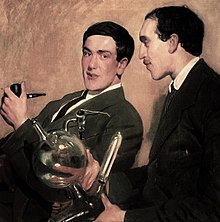Nikolay Semyonov
Nikolay Semyonov | |
|---|---|
 | |
| Born | Nikolay Nikolayevich Semyonov April 15 [O.S. April 3] 1896 |
| Died | September 25, 1986 (aged 90) |
| Nationality | Russian |
| Known for | chemical transformation |
| Awards | Nobel Prize in chemistry 1956 |
| Scientific career | |
| Fields | physicist and chemist |
| Doctoral advisor | Abram Ioffe |
Nikolay Nikolayevich Semyonov, ForMemRS[1] (Russian: Никола́й Никола́евич Семёнов; April 15 [O.S. April 3] 1896 – September 25, 1986) was a Russian/Soviet physicist and chemist. Semyonov was awarded the 1956 Nobel Prize in Chemistry for his work on the mechanism of chemical transformation.
Life and career
Semyonov was born in Saratov, the son of Elena Dmitrieva and Nikolai Alex Semyonov.[2] He graduated from the department of physics of Petrograd University (1913–1917), where he was a student of Abram Fyodorovich Ioffe. In 1918, he moved to Samara, where he was enlisted into Kolchak's White Army during Russian Civil War.
In 1920, he returned to Petrograd and took charge of the electron phenomena laboratory of the Petrograd Physico-Technical Institute. He also became the vice-director of the institute. In 1921, he married philologist Maria Boreishe-Liverovsky (student of Zhirmunsky). She died two years later. In 1923, Nikolay married Maria's niece Natalia Nikolayevna Burtseva. She brought Nikolay a son (Yuri) and a daughter (Lyudmila).
During that difficult time, Semyonov, together with Pyotr Kapitsa, discovered a way to measure the magnetic field of an atomic nucleus (1922). Later the experimental setup was improved by Otto Stern and Walther Gerlach and became known as Stern-Gerlach experiment.
In 1925, Semyonov, together with Yakov Frenkel, studied kinetics of condensation and adsorption of vapors. In 1927, he studied ionisation in gases and published an important book, Chemistry of the Electron. In 1928, he, together with Vladimir Fock, created a theory of thermal disruptive discharge of dielectrics.
He lectured at the Petrograd Polytechnical Institute and was appointed Professor in 1928. In 1931, he organized the Institute of Chemical Physics of the U.S.S.R. Academy of Sciences (which has moved to Chernogolovka in 1943) and became its first director. In 1932, he became a full member of the Soviet Academy of Sciences.
Significant works

Semyonov's outstanding work on the mechanism of chemical transformation includes an exhaustive analysis of the application of the chain theory to varied reactions (1934–1954) and, more significantly, to combustion processes. He proposed a theory of degenerate branching, which led to a better understanding of the phenomena associated with the induction periods of oxidation processes.
Semyonov wrote two important books outlining his work. Chemical Kinetics and Chain Reactions was published in 1934 with an English edition in 1935. It was the first book in the U.S.S.R. to develop a detailed theory of unbranched and branched chain reactions in chemistry. Some Problems of Chemical Kinetics and Reactivity, first published in 1954, was revised in 1958; there are also English, American, German, and Chinese editions. In 1956, he was awarded the Nobel Prize in Chemistry (together with Sir Cyril Norman Hinshelwood) for this work.
Honours and awards
- Orders of Lenin, nine times[3] (incl. 1945, 1953, 1956, 1966, 1971, 1976, 1981[4])
- Stalin Prize (1941, 1949)[4]
- Honorary Member of the British Chemical Society (1943)
- Order of the Red Banner of Labour (1946)[4]
- Honorary member of the Indian Academy of Sciences (1954)
- Nobel Prize in Chemistry (1956)
- Foreign Member of the Royal Society of London (1958)[1]
- Member of the German Academy of Naturalists[clarification needed] (1959)
- Honorary member of the Hungarian Academy of Sciences (1961)
- Honorary member of the New York Academy of Sciences (1962)
- Foreign member of the United States National Academy of Sciences (1963)
- Honorary Member of the Romanian Academy (1965)
- Hero of Socialist Labour, twice (1966, 1976)[4]
- Lomonosov Gold Medal (1969)
- Lenin Prize (1976)[4]
- Order of the October Revolution (1986)[4]
- Medal "In commemoration of the centenary of the birth of Vladimir Ilyich Lenin"
- Mendeleev Prize[4]
Semyonov was also an Honorary Doctor of several universities: Oxford (1960), Brussels (1962), London (1965), Budapest Technical University (1965), Polytechnic Institute of Milan (1964) and others.
References
- ^ a b Attention: This template ({{cite doi}}) is deprecated. To cite the publication identified by doi:10.1098/rsbm.1990.0042, please use {{cite journal}} (if it was published in a bona fide academic journal, otherwise {{cite report}} with
|doi=10.1098/rsbm.1990.0042instead. - ^ http://www.bookrags.com/biography/nikolai-n-semenov-woc/
- ^ "1956 Nobel Prize Winner in Chemistry : Soviet Scientist Nikolai Semyonov Dies". Los Angeles Times. 1 October 1986.
{{cite web}}:|access-date=requires|url=(help); Missing or empty|url=(help) - ^ a b c d e f g "Nikolai Nikolaevich Semenov". encyclopedia.com. Complete Dictionary of Scientific Biography. 2008. Retrieved 10 Oct 2011.
External links
![]() Media related to Nikolay Nikolayevich Semyonov at Wikimedia Commons
Media related to Nikolay Nikolayevich Semyonov at Wikimedia Commons
- Semyonov's Nobel Foundation biography
- Semyonov's Nobel Lecture Some Problems Relating to Chain Reactions and to the Theory of Combustion
- N.N. Semenov Institute of Chemical Physics
- Template:En icon Biography of Nikolay Semyonov at NobelPrize.org.
- Template:En icon Semyonov's Nobel Lecture.
- Template:Ru icon Semyonov's Biography.
- Template:Ru icon Another Semyonov's Biography.
- 1896 births
- 1986 deaths
- People from Saratov
- Saint Petersburg State University alumni
- Moscow Institute of Physics and Technology faculty
- Full Members of the USSR Academy of Sciences
- Foreign Members of the Royal Society
- Members of the United States National Academy of Sciences
- Members of the French Academy of Sciences
- Nobel laureates in Chemistry
- Heroes of Socialist Labour, twice
- Recipients of the Order of Lenin, nine times
- Recipients of the Order of the Red Banner of Labour
- Stalin Prize winners
- Lenin Prize winners
- Recipients of the Lomonosov Gold Medal
- Recipients of the Order of the October Revolution
- Russian chemists
- Russian Nobel laureates
- Russian physicists
- Soviet chemists
- Soviet physicists
- Tomsk State University faculty
- Tomsk Polytechnic University faculty

